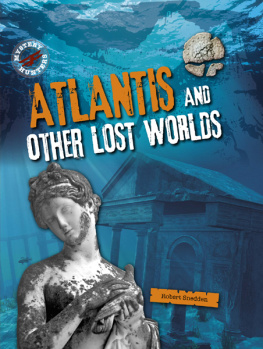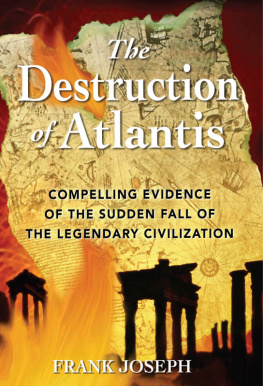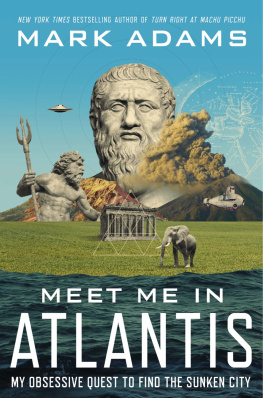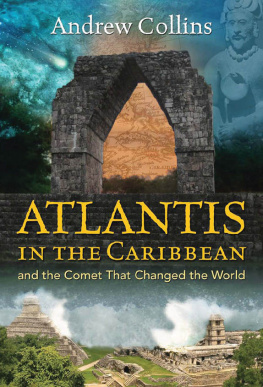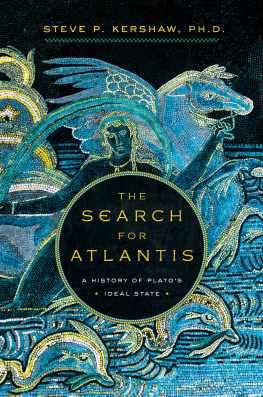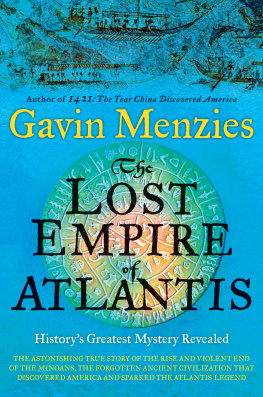Atlantis
The Find of a Lifetime
Christos A. Djonis
Copyright 2021 Christos A. Djonis
All rights reserved
First Edition
PAGE PUBLISHING, INC.
Conneaut Lake, PA
First originally published by Page Publishing 2021
ISBN 978-1-6624-4259-9 (pbk)
ISBN 978-1-6624-4127-1 (hc)
ISBN 978-1-6624-4126-4 (digital)
Printed in the United States of America
Table of Contents
If you have only one piece of circumstantial evidence, carrying that evidence to a specific conclusion is prone to significant error. However, when you have numerous pieces of circumstantial evidence all pointing in the same direction, carrying them, collectively, to a specific conclusion is usually quite reliable.
Conclusions Drawn from Circumstantial Evidence
Introduction
Nearly 2,400 years ago, the ancient philosopher Plato wrote the story of Atlantis, a compelling tale of an 11,000-year-old island civilization that since captivated the imagination of poets, authors, and many scholars minds who unsuccessfully, over the centuries, kept on searching for the elusive island.
Numerous speculations and proposed locations over the years place Atlantis in the middle of the Atlantic around the Azores Islands, in Spain, off the coast of Cyprus, in Malta, and in other more exotic locations like Indonesia, Antarctica, in the Bermuda Triangle off the coast of the United States, and a dozen other places around the world. While, of course, some of these claims over the years were noted more than others, the fact is, never has there been a real discovery where all the physical characteristics of a proposed location matched Platos description or given chronology. Not even the popular Santorini hypothesis could adequately meet the given criteria. Platos specified chronology was entirely discarded by those who proposed the original theory while the primary island of Atlantis, a massive island that was supposed to be 9 kilometers away from the circular island-within-an-island setting, is entirely missing from the Santorini backdrop of 1,600 BC. This, along with several other inconsistencies, was the reason why skeptics in the past dismissed the Santorini hypothesis and continued to adhere to their claim that Platos story was just a cautionary tale.
Were the Atlanteans a truly prehistoric civilization as Plato claimed, or was that a myth? Was the story of Atlantis entirely a product of Platos imagination, or is it possible he created a fable around a real setting and a prehistoric civilization known to ancient Greeks, which, in order to successfully communicate some of his philosophical ideas (divine vs. human, ideal societies vs. corrupt), he applied familiar matter and details from his own era, just as Homer did with Troy a few hundred years earlier. In Troys case, after ditching all the details regarding beauty queens, demigods, and Trojan horses and scaled back the armies to more rational levels, it was ultimately acknowledged that the setting, as well as the bulk of this story, was real. Essentially, Homers entirely fictional story, which he filled with principles and elements from his own period, apparently revolved around an actual setting and a real incident that took place nearly six centuries before his time.
So if Plato did with Atlantis what Homer did with Iliad, then just as in Troys case, the true part of this story should not rest in the story details but in the detection and authentication of Platos lost island. Locating a perfectly matching site and, along with it, signs of a prehistoric civilization in the immediate area should be the first step in solving this mystery.
After years of extensive research, in conjunction with new archaeological evidence, and with the aid of satellite technology, we now have a real discovery of a prehistoric partially submerged setting where all the physical characteristics, along with Platos given chronology, perfectly match. DNA and archaeological evidence of an advanced Neolithic civilization occupying the prehistoric submerged island, at around 9,600 BC, further confirms a perfect case scenario.
Embark on a chronicled 10,000-year epic journey that reveals Atlantiss submerged island, and find out how Platos 2,000-year-old legend transforms into real history.
Atlantis Revealed
Was the Great Flood a Real Event?Was North America Colonized by a Mediterranean Culture 11,000 Years Ago?The Kennewick Man.
Did a Bronze Age Visitor Help the Mayan Establish Their Civilization?
The Metcalf Stone. Who Were the Minoans?Atlantis Revealed.
The Great Sphinx: Older Than the Pyramids? Who Erected Stonehenge? The Meaning Behind the Stone Circles of Europe. Who Were the Clovis People? The Phaistos Disc.
While the twentieth century brought to us some of the most incredible scientific breakthroughs humanity ever witnessed, we must not discount the fantastic achievements and technological wonders left behind by past human civilizations. Aside from the several megalithic monuments antiquity left behind, there are also many smaller marvels of ancient ingenuity that confront our awareness and demonstrate our ancestors exceptional technological abilities.
Excavations on the Greek island of Santorini (Thera) revealed that the 3,600-year-old Bronze Age city of Akrotiri featured advanced multilevel housing structures with indoor plumbing, complete with sewer and water supply lines for both hot and cold water.
This discovery is incredible because up until recently, we were under the impression that it was the Romans who were first able to utilize such technology, nearly 1,500 years later.
The Bronze Age city of Akrotiri on the island of Santorini (Thera) Greece
What about the Antikythera Mechanism (an extremely complex device designed to calculate astronomical positions at any given moment in time)? It was found at the bottom of the Aegean Sea near the Greek island of Antikythera, hence its name. Made of several bronze wheels and other mechanical components more than 2,000 years ago, this device is so incredible that, at first glance, it resembles a twentieth-century piece of equipment. Indeed, when it was first discovered, it was mistaken as such. An x-ray of the mechanism revealed that instruments of this complexity were not known to exist at least until the seventeenth century.
Who designed and constructed this remarkable device or how this technology was lost afterward is not entirely clear. Labeled by scientists as the first mechanical computer in history, this incredible feat of engineering required that its maker had advanced knowledge of astronomy, as well as a diverse knowledge in mechanics and machine making.
The Antikythera Mechanism displayed at the National Archaeological Museum of Athens, Greece
After 75 years deciphering the mechanism, researchers concluded that the ancient device was used as a type of timepiece, based on a geocentric view of the universe. However, instead of hours and minutes, it displayed celestial time and had different hands for the Sun, the Moon, and the five planets visible to the naked eye (Mercury, Venus, Mars, Jupiter, and Saturn). A rotating ball showed the Moon, while dials phase on the back acted as a calendar and showed lunar and solar eclipses. Captions explained which stars rose and set on any particular date. The most incredible part about this mechanism is that the mechanical gears precision, which accurately showed all planetary motions, was based on mathematics.



